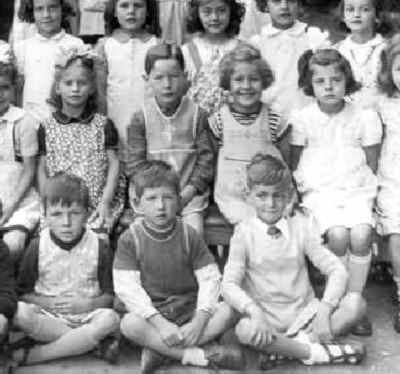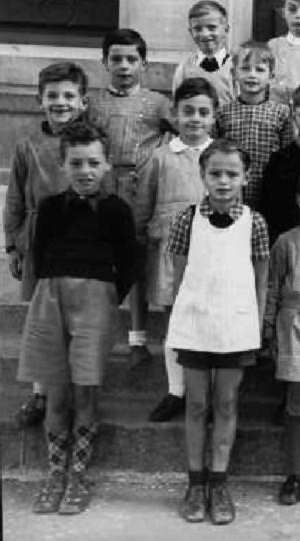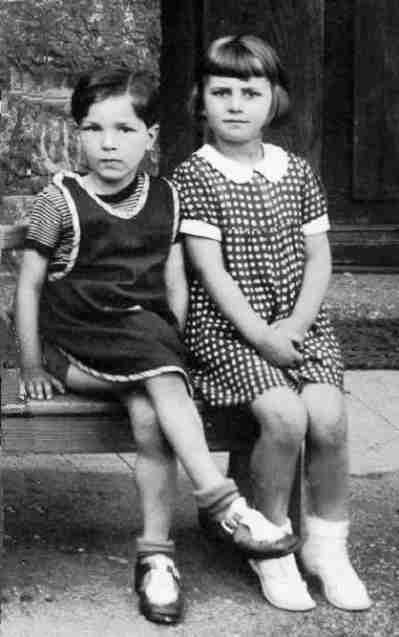
Figure 1.--All of the boys and many of the boys in this Swiss class wore smocks, mostly the inexpensive apron or pinafore style. In this SWiss class all the boys wear smocks, but only some of the girls. The children look to be about 7 years old.

Some boys and girls wore a very simple style of smock. They varied in construction, but were basically sleevless covers back and from with simple ties. They were inexpensive garments, but not commonly set as a school uniform. They were more commonly chosen by individual parents. It appears to have been a post-World War II style that was popular until the 1970s for younger children.
As HBC believes this to be primarily a French style, we will provide a French summary for out French readers. The French text may also be useful for English readers desiring to persue the subject in French sources as it provides the French terms. Resumé pour nos lecteurs francophones. Nous pensons à HBC que ce style est particulier à la France et nous projetons d'écrire un résumé en français pour nos lecteurs francophones qui sont les bienvenus à nous apporter leurs
propres expériences. De même pour les visiteurs anglophones désireux d'aprofondir le sujet auprès de sources francophones, en particulier quant à la terminologie.
Quelques garçons et filles avaient un tablier de style trés simple, de formes variées, sans manches et avec des bretelles. Il s'agissait de vêtements bon marché n'ayant pas un caractére spécifique d'uniforme pour l'école, et laissé au libre choix des parents. Il semble qu'il s'agisse là d'un style de l'après-deuxième guerre mondiale qui fût à la
mode pour de jeunes garçons jusqu'aux années 1970.
This style of smocks was referred to in a variety of different ways. It was a pinafore ("????") or apron ("????") style. Another common way of describing it was a gardeners ("????") smock.
Some boys and girls wore a very simple style of smock. They varied in construction, but were basically sleeveless covers back and from with simple ties. Many buttoned at the shoulders. Some had a pocket in the front. They were inexpensive garments.
HBC is not sure of just when the pinafore/apron smock originated. HBC has not noted this style before World War II style. A Swiss contributor believes, however, that the style appeared in the 1930s well before World War II. These smocks were worn until the 1970s.
The apron or pinafore style appears to have been worn was worn mostly by younger children. Some images show boys about 7 or 8 wearing this style of smock, but older boys were more like to wear the more traditional smock with long sleeves. HBC speculates that the boys wearing this style of smock, usually did not wear smocks at home. (This may be, however, a generalization. See "Conventions" below.) As soon as these boys reached the age that smocks were no longer required by the school, they stopped wearing them. Some of the bouys wearing the other smock styles, however, were more likely to continue wearing them even though it was no longer compulsory.
There appears to have been no gender conotations concerning this style of smock.
HBC currently has little information on this style of smock. The available images are from a French-language school in Switzerland. HBC assumed that this meant that French boys also wore this style. HBC's Swiss contributor, however, reports that he does not believe that the pinafore/apron smock was a specifically Fench style. He would rather call it a specialty of Romandie (French speaking part of Switzerland). He reports that French smocks were more of the back-buttoning type and of grey or black colors. HBC has not noted the pinafore/apron smocks being worn elsewhere in Europe.
The few available images show that the pinafore or apron smock was made in a wide variety of colors. They appear to be mostly in light colors. I'm not sure if this reflects the style or the the country. Looking at the smocks for the younger children (figure 1), there look to be many shades of grey--suggesting a variety of colors. The older boys wore a more narrow range of colors--usually black and a range of blue shades. There were also some white smocks. Generally speaking, the pinafore-type smock was usually a solid-color smock. Girls smocks were often employed more colors which is why the boys in the mixed class (figure 1), appear to be wearing a wider range of colors than older boys in all-boys primary schools.
Some of the pinafore or apron smocks gave detailing or piping around the garment edges. Some also appear to have embroidered designs on the front.

Figure 2.--Some of the pinafore or apron style school smocks were very simple garments. They were usually worn by boys who did not wear smocks at home. |
One attractive faeture of many pinafore smock was their big central pocket for the handkerchief and the usual small treasures of a young boy. Not all the pinafore smocks had this pocket, but the better ones did. This was a popular feature with the boys.
These pinafore smocks were worn with a wide variety of clothing types. Most boys wore them with open collar shirts, but some were worn with ties. Generally boys wore them with short pants and both short and kneesocks. Closed-toe sandals were often worn with them, both the English "T" strap style and the double strap style. HBC believes that the boys most likely to wear thise style of smock to school were the boys least likely to wear smocks at home. Presumably many mothers insisting on smocks at home would have wanted the more traditional style that better protected the boy's clothes.
This style of school smock was not always set by the school. Many schools in Frence, Italy, Spain, Turkey, and other countries did rquire smocks. In some cases it was a national regulation which even established the style of smock. In other cases requiring a smock was left up to the individual school. Often a school might require a smock, but not establish a specific style. In other cases the parents, usually the mother simply insisted on a smock with out any school rule. The schools even if they did require a smock, did not usually have rules for the clothes to be worn with the smock. The pinafore or apron style was a common choice for boys who did not wear smocks at home because it was so inexpensive.
The pinafore or apron smock style was usually worn at state schools which required the boys to wear smocks. Some mothes liked the idea and bought traditional smocks that more fully protected a boys' clothes. Other mothers just wnt along with the chool regulation and bought the cheapest smock possible. This was also a popular choice for low income families. Private schools, however, rarely chose the pinafore or apron style.

Figure 3.--This Swiss boy wears a pinafore/apron smock. It was probably blue with white trim edging. Note that the boy wears a smock, but that his older sister does not. |
HBC speculates that the boys wearing the simple pinafore smocks were the least likely to wear smocks at home. HBC's Swiss contrinutor replies, "You might be right, but I am not quite sure about it. Smocks were in fact part of daily clothing of many boys and not for school only. Many boys played in streets in their smocks--including the pinafore-style smock. Quite often boys had a brand new smock for school and an old one for wearing around home. The pinafore smock was worn just like regular mocks. The only real difference was the cheaper purchase price. On top of that for the boys, wearing a smock or pinafore at home meant one more available pocket!
HBC has no information at this time as to how popular the pinafore or apron style smock was with the children, either boys or girls. As few images show older boys wearing them, the inference is that they were not very popular. A Swiss ciontributor stresses, however, that boys in the 1940s and 50s were not as interested in clothes as modern boys and parents were not as willing to give any importance to anything a boy might have to day about his clothes. Boys did seem to like the extra pockets, however, the fact that older boys did not wear them and that they were not commonly worn when not require, suggests to HBC that they were not very popular with the boys.
Smocks in general appear to have been popular with mothers as they protected the clothes of younger children who could be quite careless. Mothers who approved of smocks, however, appear to have chosen other styles which more fully covered their son's clothes. This style appears to hasve been popular with mothers who were not that interested in smocks and were just complying with a school rule. Some mothers may have chosen this style of smock because it was very inexpensive.
Navigate the Historic Boys' Clothing Web Site:
[Return to the Main school smock style page]
[Introduction]
[Activities]
[Bibliographies]
[Biographies]
[Chronologies]
[Contributions]
[Countries]
[Expanded Site]
[Frequently Asked Questions]
[Style Index]
[Boys' Clothing Home]
Navigate the Historic Boys' Clothing Web chronological pages:
[The 1890s]
[The 1900s]
[The 1910s]
[The 1920s]
[The 1930s]
[The 1940s]
[The 1950s]
[The 1960s]
Navigate the Historic Boys' Clothing Web style pages:
[Return to the Main school garment page]
[Return to the Main smocks page]
[Dresses]
[Bodice dresses]
[Kilts]
[Sailor suits]
[Sailor hats]
[Ring bearer/page costumes]
[Pinafores]
[Shortalls]
